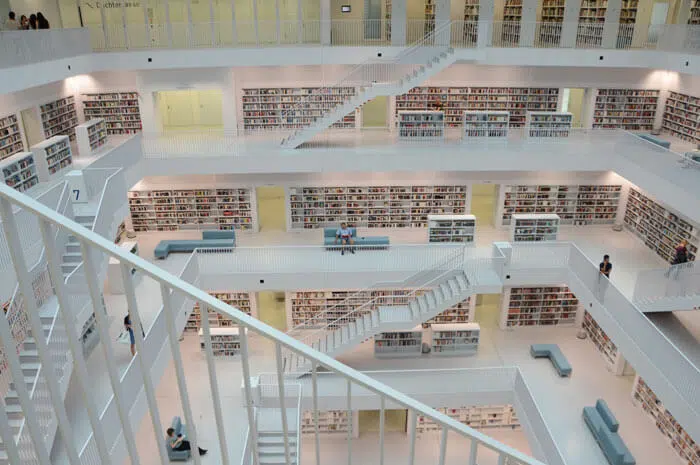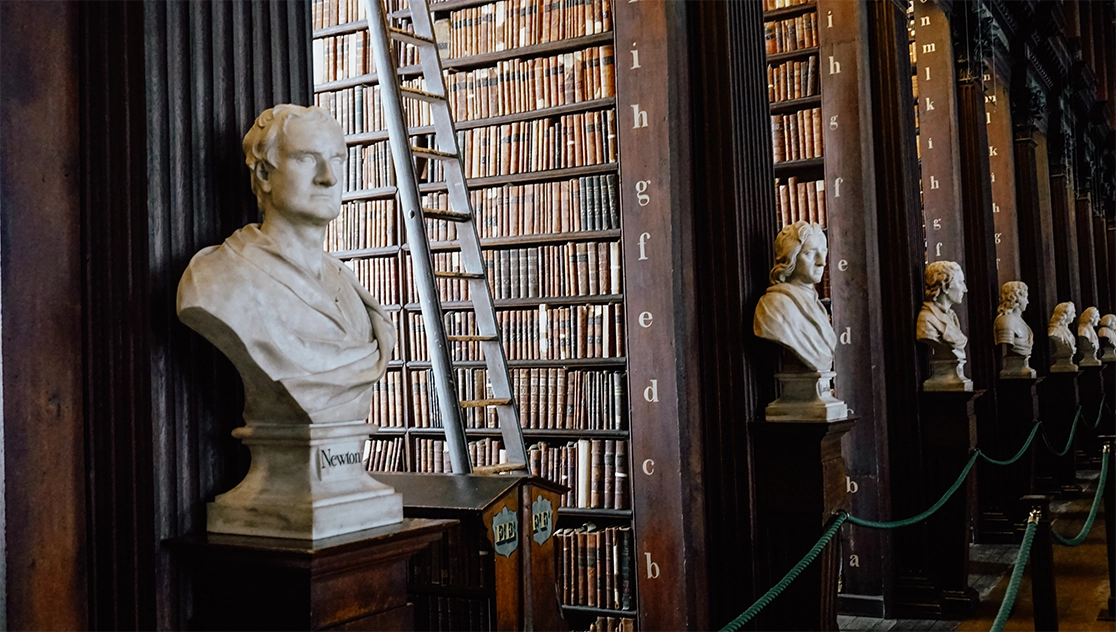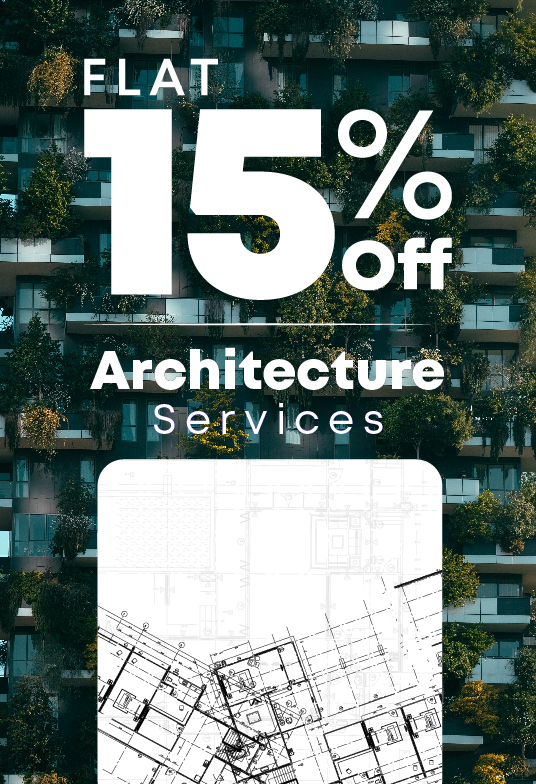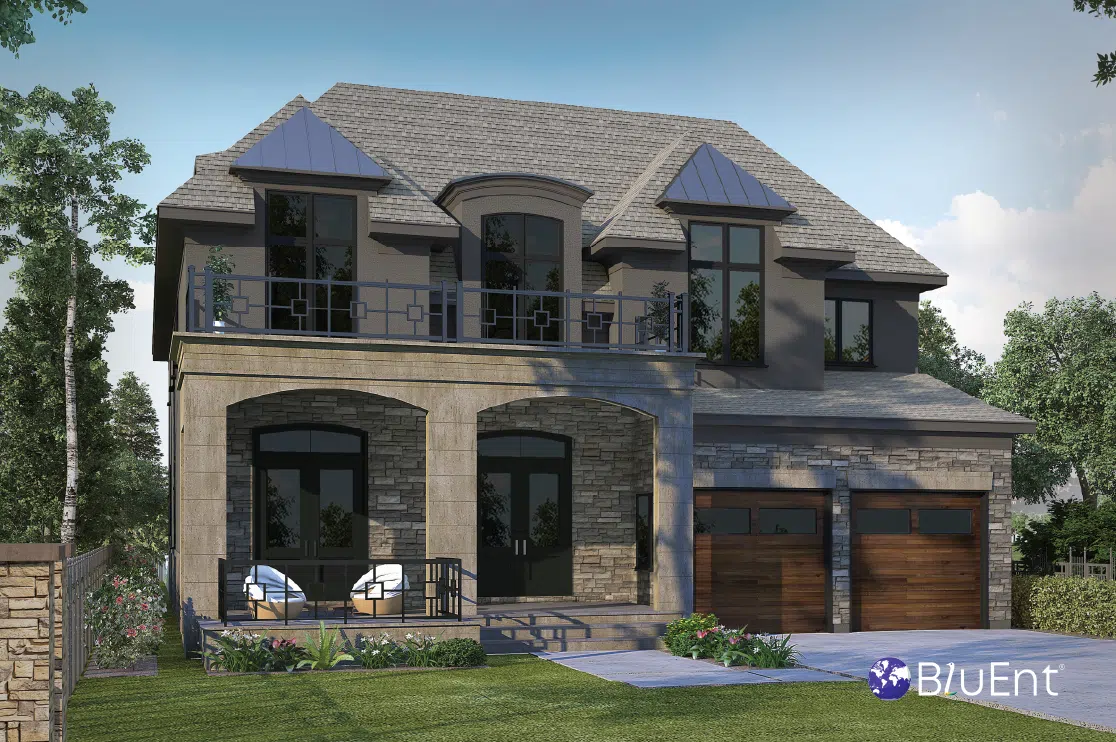Libraries aren’t just places to store books and take Instagram photos. They are hubs of knowledge, activity and technology that can be ambitious in scale and design. To create appropriate, safe and comfortable areas for study, reading, research and even socializing, we need to know the principles of modern library design. This is also helpful for creating the best construction drawings for building a library.
Current expectations for libraries are high. Indeed, library building projects are especially complex in terms of purpose, audience, and equipment. Designers, architects and engineers are working to create striking exteriors and interiors to attract a wide variety of people. Many of these projects focus on multi-settings for engagement, and aim for adaptability as well as a strong sense of place.
Table of Contents
Much of your library architecture project will depend on the unique purpose of the library, as well as the culture of the country or area.
Having said that, there are some general principles that are important to bear in mind so that you can get a more complete idea of modern library architecture.
Modern library design is an ever-evolving craft. Even as technology changes the dynamics of our spaces, we crave familiar acts such as sliding out a novel from a bookshelf with a ladder.
There has never been a more exciting time for modern library design. One need not stick to the stereotypical idea of libraries as places of reverent silence and seriousness. New generations of library users are being lured by friendly, bright spaces. Environment and ambience occupy an important rung of the design ladder when it comes to competing for customers – especially since many younger people’s idea of interior design is influenced by high streets and shopping malls.
For examples of modern library design, you can look to successful modern libraries such as the Matsubara library in Japan, the Tianjin Binhai Library in China, and La Trobe University Library in Australia. Which design most tickles your fancy? Let us know in the comments!
Types of Libraries
You need to know the type of library you will be building. Here are the types.
1. Research Libraries
- Contains a collection of materials on one or more subjects.
- Supports scientific or scholarly research.
- Strives to provide access to all required materials.
- Often a national or academic library.
- Includes primary and secondary sources.
- Maintains permanent collections.
- A larger specialty library might contain a research library within its field.
2. Digital Libraries
- House digital information and resources.
- Defined as an organization rather than a service.
- Usually provides items easily and affordably.
- Has a responsibility to provide future access to materials.
3. Academic Libraries
- On university and college campuses.
- Aimed to serve students, faculty, and other academic institutions.
- Help improve reading culture around the world.
- Provides resource linkage, research support and consultancy.
- House reliable, relevant and current information across various disciplines.
4. Children’s Libraries
- Contain collections of books meant for juvenile readers.
- Often kept in separate rooms in public libraries.
- Commonly provide services such as storytelling sessions for preschool children, toddlers and infants, as well as after-school programs.
- Aim to develop early love for reading and literacy skills.
5. Public Libraries
- Also called public lending libraries.
- Cater to the public.
- Might be part of a countywide system, in which case citizens can use all branches if they have an active library card.
- Almost all materials are available for borrowing.
- Typically issue library cards to community members who want to borrow books.
- Library staff are in charge of the details of borrowing time and number of items borrowed.
- Visitors to a city can often obtain a public library card.
6. National Libraries
- House national collections of books, maps, journals, etc.
- Can house significant and/or rare works.
- Rarely allow citizens to borrow books.
- Tend to be large and research-focused.
- Are assigned the duty of collecting & preserving the literature of a country.
Top 6 Key Elements to Consider in Modern Library Design
1. Furnishings
The furnishings in your library will play a crucial role in enhancing the patrons’ experience. Choose furniture that will help you meet your goals, whether that’s facilitating connections, nurturing creativity or showing collections.
We suggest avoiding blocky, heavy furniture and instead using nimble furniture that can be moved around easily so that the space becomes more flexible. Consider:
- Height-adjustable desks
- Flip-top surfaces
- Side storage bins
- Modular components
- Shelving on casters
- Moveable walls
If you want to capture people’s attention, go for displays featuring beautiful, popular or timely content in high-traffic areas. For example, many books have incredible artwork, so instead of having the spine facing out, you can display the cover or inner pages.
2. A Transformational Experience
Ideally, modern library architecture will empower patrons to have the types of experiences they and their communities want. Libraries are becoming more than just spaces to borrow books – they are spaces to collaborate and connect.
As libraries acquire more digital materials, they can afford to devote less space to physical items. The modern library provides a multifunctional space for people to interact and learn new skills. It is, in essence, a meeting place, a cafe, a digital creation studio, and more.
Many modern libraries are also taking merchandising ideas from retail stores for increased circulation and more convenient borrowing. They are also making use of outdoor spaces.
To give your patrons a transformational experience, consider:
- Kitchenettes
- Cafés
- Shallow raised floors
- Public meeting spaces
- Mobile service desks
- Gaming computers
- Glass walls that bring the outdoors in
- Lounge areas (consider warm, inviting furniture, a fireplace, and wood paneling)
- Courtyards
- Conference rooms that double as makerspaces
- Video editing stations
- Classes on various topics, whether 3D modeling or digital art or anything else
3. Communities
Ray Johnston, founder of Johnston Architects, says, “Libraries serve as the living room of the community.”
For library building design to support a given community’s wants, designers must first understand their needs. This can be done through an extensive listening process.
From this, you can gauge whether the community wants a specific location, flexibly located outlets, integration with outdoor spaces, more meeting areas, etc.
4. Sustainability
Sustainable library design is part of the larger trend of sustainable architecture. There are various steps you can take to ensure your library is not a complete blight on the environment. Here are some of them.
- Minimize space usage by using an efficient and pleasing sense of space
- Use roof areas for solar panels and plants
- Maintenance-friendly construction
- Thermal insulation
- Switchable sockets for PCs and printers
- Spaces for bicycles
- Define and control the library’s ecological footprint
- Natural ventilation
- Power supply from renewable energy source
- Light as required (dimmer switches, step switching)
- Water saving features
If you need to understand what your sustainable library will look like before it is built, we suggest going for 3D exterior rendering or an architectural walkthrough.
5. Colors
The color scheme you choose for your library – or the various spaces within it – will need to appeal to people of all ages and backgrounds. Furthermore, it will help if you understand the purpose of the spaces, as well as the weather patterns in the area. Smaller, more cramped spaces will want lighter colors, while frigid temperatures may warrant warmer color schemes.
Many modern libraries utilize vibrant colors such as orange, red and blue. These lend a playful, energetic, and casual air to the space – perfect for younger library-goers or college students running on five hours of sleep and a cappuccino.
A more classic (or old-fashioned) look would involve richer and darker colors, coupled with wood furniture and warm lighting. Think dusty blue, dark green, and moody maroon.
Experts recommend using a classic color theory instead of what’s trending so it won’t look dated in a few years. Having said that, there are few right or wrong answers. After all, if a glossy teal accent wall is suiting the space, why shouldn’t you use it?
6. Location & Zoning
The location of a library will depend largely on its purpose. For simplicity, we will talk about public libraries in this section.
- Ideally, public libraries will be well-connected to civic life and centrally located.
- They should be accessible via public transport. Furthermore, pedestrians of all abilities should be able to access them.
- Many public libraries offer a gathering space at the entrance, which is often used as a break area and a place to congregate.
Understanding how your library will be used is a key element of modern library design for establishing the various zones and spaces. Generally, library spaces can be separated into main areas, including but not limited to:
- IT space (public)
- Meeting spaces (public)
- Seating & work spaces (public)
- Sanitary facilities
- Staff work areas
Optimize these spaces so that people feel welcome and comfortable. For instance, soft music in the background and a variety of table, lounge and bar seating will work well in a vibrant cafe. Community-based art and displays should go in a bookstore, and encourage browsing and exciting discoveries. Nesting tables and stacking chairs will be useful for a community meeting room.
Other Tips on How to Design a Library
- Always bear in mind the effects of architecture on mood
- Manage very large spaces by creating “barriers” with furniture such as carpets, tables, lamps and seating
- Avoid drawing attention to awkward or unattractive features such as blinds, radiators and piping
- Integrate signage with graphic themes
Conclusion
Modern library design encourages multiple uses and connections. Natural light, openness and a variety of settings are also integral to them.
For your library to best serve your patrons, you will require construction documentation. You needn’t look far for that. BluEntCAD provides architectural construction drawings to architectural companies, homebuilders, real estate developers, engineering companies, and custom home designers for large to medium projects.
Ready to make your library construction project a success with construction drawing services? Contact us now!
Maximum Value. Achieved.








 How 3D Architectural Visualization Boosts Property Pre-Sales?
How 3D Architectural Visualization Boosts Property Pre-Sales?  A Guide to 3D Condo and Apartment Rendering for Residential Projects
A Guide to 3D Condo and Apartment Rendering for Residential Projects  Details of Modern Ranch Style Open Floor Plans for Builders & Buyers
Details of Modern Ranch Style Open Floor Plans for Builders & Buyers  How 3D Landscape Designs for Exteriors Can Elevate your Property’s Value
How 3D Landscape Designs for Exteriors Can Elevate your Property’s Value